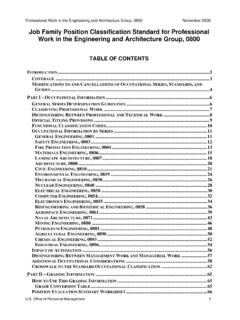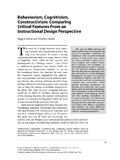Transcription of Statistics and Probability for Engineering Applications
1 Statistics and Probability for Engineering Applications With Microsoft Excel [This is a blank page.] Statistics and Probability for Engineering Applications With Microsoft Excel by DeCourseyCollege of Engineering , University of Saskatchewan Saskatoon Amster dam Boston London New York Oxfor d Paris San Diego San Francisco Singapor e Sydney Tokyo Newnes is an imprint of Elsevier Science. Copyright 2003, Elsevier Science (USA). All rights reserved. No part of this publication may be reproduced, stored in a retrieval system, or transmitted in any form or by any means, electronic, mechanical, photocopy ing, recording, or otherwise, without the prior written permission of the publisher. Recognizing the importance of preserving what has been written, Elsevier Science prints its books on acid-free paper whenever possible.
2 Library of Congress Cataloging-in-Publication Data ISBN: 0-7506-7618-3 British Library Cataloguing-in-Publication Data A catalogue record for this book is available from the British Library. The publisher offers special discounts on bulk orders of this book. For information, please contact: Manager of Special Sales Elsevier Science 225 Wildwood Avenue Woburn, MA 01801-2041 Tel: 781-904-2500 Fax: 781-904-2620 For information on all Newnes publications available, contact our World Wide Web home page at: 10 9 8 7 6 5 4 3 2 1 Printed in the United States of America Contents Preface .. xi What s on the CD-ROM? .. xiii List of Symbols .. xv 1. Introduction: Probability and 1 Some Important Terms .. 1 What does this book contain? .. 2 2. Basic 6 Fundamental Concepts.
3 6 Basic Rules of Combining Probabilities .. 11 Addition Rule .. 11 Multiplication Rule .. 16 Permutations and Combinations .. 29 More Complex Problems: Bayes Rule .. 34 3. Descriptive Statistics : Summary Numbers .. 41 Central Location .. 41 Variability or Spread of the Data .. 44 Quartiles, Deciles, Percentiles, and Quantiles .. 51 Using a Computer to Calculate Summary Numbers .. 55 4. Grouped Frequencies and Graphical 63 Stem-and-Leaf Displays .. 63 Box Plots .. 65 Frequency Graphs of Discrete Data .. 66 Continuous Data: Grouped Frequency .. 66 Use of Computers .. 75 v 5. Probability Distributions of Discrete Variables .. 84 Probability Functions and Distribution Functions .. 85 (a) Probability Functions .. 85 (b) Cumulative Distribution Functions .. 86 Expectation and Variance.
4 88 (a) Expectation of a Random Variable .. 88 (b) Variance of a Discrete Random Variable .. 89 (c) More Complex Problems .. 94 Binomial Distribution .. 101 (a) Illustration of the Binomial Distribution .. 101 (b) Generalization of Results .. 102 (c) Application of the Binomial Distribution .. 102 (d) Shape of the Binomial Distribution .. 104 (e) Expected Mean and Standard Deviation .. 105 (f) Use of Computers .. 107 (g) Relation of Proportion to the Binomial Distribution .. 108 (h) Nested Binomial Distributions .. 110 (i) Extension: Multinomial Distributions .. 111 Poisson Distribution .. 117 (a) Calculation of Poisson Probabilities .. 118 (b) Mean and Variance for the Poisson Distribution .. 123 (c) Approximation to the Binomial Distribution .. 123 (d) Use of Computers.
5 125 Extension: Other Discrete Distributions .. 131 Relation Between Probability Distributions and Frequency Distributions .. 133 (a) Comparisons of a Probability Distribution with Corresponding Simulated Frequency Distributions .. 133 (b) Fitting a Binomial Distribution .. 135 (c) Fitting a Poisson Distribution .. 136 6. Probability Distributions of Continuous Variables .. 141 Probability from the Probability Density Function .. 141 Expected Value and Variance .. 149 Extension: Useful Continuous Distributions .. 155 Extension: Reliability .. 156 vi 7. The Normal 157 Characteristics .. 157 Probability from the Probability Density Function .. 158 Using Tables for the Normal Distribution .. 161 Using the Computer .. 173 Fitting the Normal Distribution to Frequency Data.
6 175 Normal Approximation to a Binomial Distribution .. 178 Fitting the Normal Distribution to Cumulative Frequency Data .. 184 Transformation of Variables to Give a Normal Distribution .. 190 8. Sampling and Combination of Variables .. 197 Sampling .. 197 Linear Combination of Independent Variables .. 198 Variance of Sample Means .. 199 Shape of Distribution of Sample Means: Central Limit Theorem .. 205 9. Statistical Inferences for the 212 Inferences for the Mean when Variance Is Known .. 213 Test of Hypothesis .. 213 Confidence Interval .. 221 Inferences for the Mean when Variance Is Estimated from a Sample .. 228 Confidence Interval Using the t-distribution .. 232 Test of Significance: Comparing a Sample Mean to a Population Mean .. 233 Comparison of Sample Means Using Unpaired Samples.
7 234 Comparison of Paired Samples .. 238 10. Statistical Inferences for Variance and Proportion .. 248 Inferences for Variance .. 248 Comparing a Sample Variance with a Population Variance .. 248 Comparing Two Sample Variances .. 252 Inferences for Proportion .. 261 Pr oportion and the Binomial Distribution .. 261 vii Test of Hypothesis for Proportion .. 261 Confidence Interval for Proportion .. 266 Extension .. 269 11. Introduction to Design of 272 Experimentation vs. Use of Routine Operating Data .. 273 Scale of Experimentation .. 273 One-factor-at-a-time vs. Factorial Design .. 274 Replication .. 279 Bias Due to Interfering Factors .. 279 (a) Some Examples of Interfering Factors .. 279 (b) Preventing Bias by Randomization .. 280 (c) Obtaining Random Numbers Using Excel.
8 284 (d) Preventing Bias by Blocking .. 285 Fractional Factorial Designs .. 288 12. Introduction to Analysis of Variance .. 294 One-way Analysis of Variance .. 295 Two-way Analysis of Variance .. 304 Analysis of Randomized Block Design .. 316 Concluding Remarks .. 320 13. Chi-squared Test for Frequency Distributions .. 324 Calculation of the Chi-squared Function .. 324 Case of Equal Probabilities .. 326 Goodness of Fit .. 327 Contingency Tables .. 331 14. Regression and Correlation .. 341 Simple Linear Regression .. 342 As sumptions and Graphical Checks .. 348 Statistical Inferences .. 352 Other Forms with Single Input or Regressor .. 361 Correlation .. 364 Extension: Introduction to Multiple Linear Regression .. 367 viii 15. Sources of Further Information.
9 373 Useful Reference Books .. 373 List of Selected References .. 374 Appendices .. 375 Appendix A: Tables .. 376 Appendix B: Some Properties of Excel Useful Appendix C: Functions Useful Once the During the Learning Process .. 382 Fundamentals Are 386 Appendix D: Answers to Some of the Problems .. 387 Engineering Problem-Solver Index .. 391 Index .. 393 ix [This is a blank page.] Preface This book has been written to meet the needs of two different groups of readers. On one hand, it is suitable for practicing engineers in industry who need a better under standing or a practical review of Probability and Statistics . On the other hand, this book is eminently suitable as a textbook on Statistics and Probability for Engineering students. Areas of practical knowledge based on the fundamentals of Probability and Statistics are developed using a logical and understandable approach which appeals to the reader s experience and previous knowledge rather than to rigorous mathematical development.
10 The only prerequisites for this book are a good knowledge of algebra and a first course in calculus. The book includes many solved problems showing Applications in all branches of Engineering , and the reader should pay close attention to them in each section. The book can be used profitably either for private study or in a class. Some material in earlier chapters is needed when the reader comes to some of the later sections of this book. Chapter 1 is a brief introduction to Probability and Statistics and their treatment in this work. Sections and of Chapter 2 on Basic Probability present topics that provide a foundation for later development, and so do sections and of Chapter 3 on Descriptive Statistics . Section , which discusses representing data for a continuous variable in the form of grouped fre quency tables and their graphical equivalents, is used frequently in later chapters.






